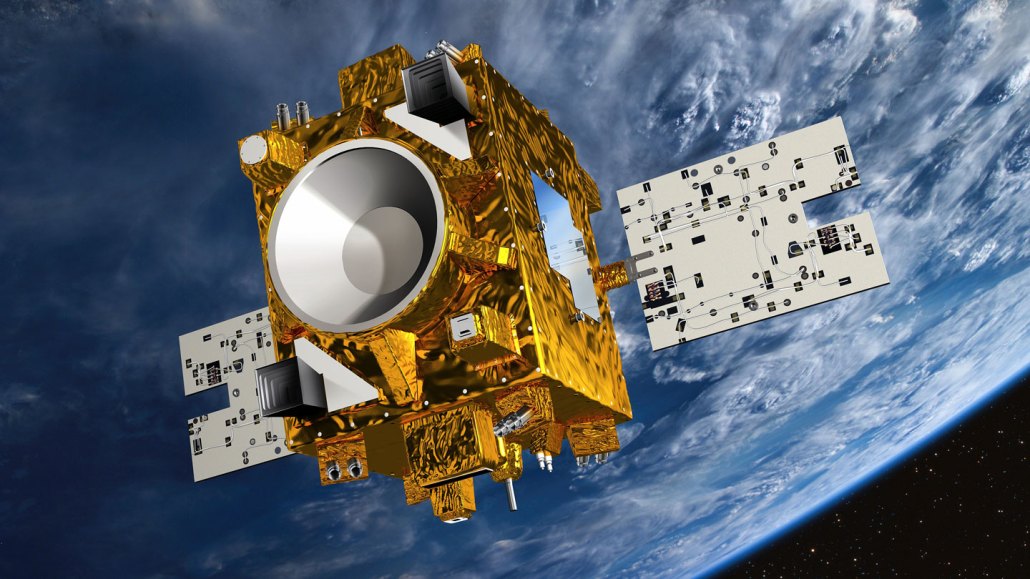Falling objects in orbit show Einstein was right — again
An experiment provides the most precise confirmation yet of a key tenet of general relativity

The final results from the orbiting MICROSCOPE experiment (illustrated) provide the most precise confirmation yet that all things fall the same way under the influence of gravity.
© CNES 2015
- More than 2 years ago
Gravity doesn’t discriminate. An experiment in orbit has confirmed, with precision a hundred times greater than previous efforts, that everything falls the same way under the influence of gravity.
The finding is the most stringent test yet of the equivalence principle, a key tenet of Einstein’s theory of general relativity. The principle holds to about one part in a thousand trillion, researchers report September 14 in Physical Review Letters.
The idea that gravity affects all things equally might not seem surprising. But the slightest hint otherwise could help explain how general relativity, the foundational theory of gravity, meshes with the standard model of particle physics, the theoretical framework that describes all fundamental particles of matter. General relativity is a classical theory that sees the universe as smooth and continuous, whereas the standard model is a quantum theory involving grainy bits of matter and energy. Combining them into a single theory of everything has been an unfulfilled dream of scientists extending back to Einstein (SN: 1/12/22).
“The equivalence principle is the most important cornerstone of Einstein’s theory of general relativity,” says Sabine Hossenfelder, a physicist with the Frankfurt Institute for Advanced Studies in Germany who was not involved in the study. “We know [it] eventually has to be altered because it cannot in its present form take into account quantum effects.”
To help search for potential alterations, the MICROSCOPE experiment tracked the motion of nested metal cylinders — a 300-gram titanium outer cylinder and a 402-gram platinum inner one — as they orbited the Earth in near-perfect free fall. Any difference in the effect of gravity on the respective cylinders would cause them to move relative to each other. Small electrical forces applied to bring the cylinders back into alignment would have revealed a potential violation of the equivalence principle.
From April 2016 to October 2018, the cylinders were shielded inside a satellite that protected them from the buffeting of solar winds, the minuscule pressure that sunlight exerts and the residual atmosphere at an orbital altitude of a little over 700 kilometers high.
By performing the experiment in orbit, the researchers could compare the free fall of two different materials for extended periods without the confounding effects of vibrations or of objects nearby that could exert gravitational forces, says Manuel Rodrigues, a MICROSCOPE team member and physicist with the French aerospace lab ONERA in Palaiseau. “One of the lessons learned by MICROSCOPE is … that space is the best way to get an important improvement in the accuracy for this kind of test.”
Over its two-and-a-half-year mission, MICROSCOPE found no sign of cracks in the equivalence principle, the new study reports. The finding builds on a previous interim report from the experiment that found the same thing, but with less precision (SN: 12/4/17).
Some physicists suspect that limits to the equivalence principle may never turn up in experiments, and that Einstein will perpetually be proven right.
Even 100 times greater precision from a follow-up MICROSCOPE 2 mission, tentatively planned for the 2030s, is unlikely to reveal an equivalence principle breakdown, says Clifford Will, a physicist at the University of Florida in Gainesville who is not affiliated with the experiment. “It really is still this basic idea that Einstein taught,” he says. What we see as the force of gravity is actually the curvature of spacetime. “Any body simply moves along the path in Earth’s spacetime,” whether it’s made of dense platinum, lighter titanium or any other material.
But even if physicists never prove Einstein wrong, Hossenfelder says, experiments like MICROSCOPE are still important. “These tests aren’t just about the equivalence principle,” she says. “They implicitly look for all other kinds of deviations, new forces and so on,” that aren’t part of general relativity. “So really it’s a multiple-purpose, high-precision measurement.”
Now that the mission is complete, the MICROSCOPE satellite will slowly spiral out of orbit. “It’s difficult to bet where in 25 years it will fall down,” Rodrigues says. Along with a reference set of platinum cylinders on board, “it’s [a] couple of millions of euros [in] platinum.” Where that precious platinum metal will land is anyone’s guess, but the gravity that pulls it down will tug on the titanium just as hard, to one part in a thousand trillion at least.






